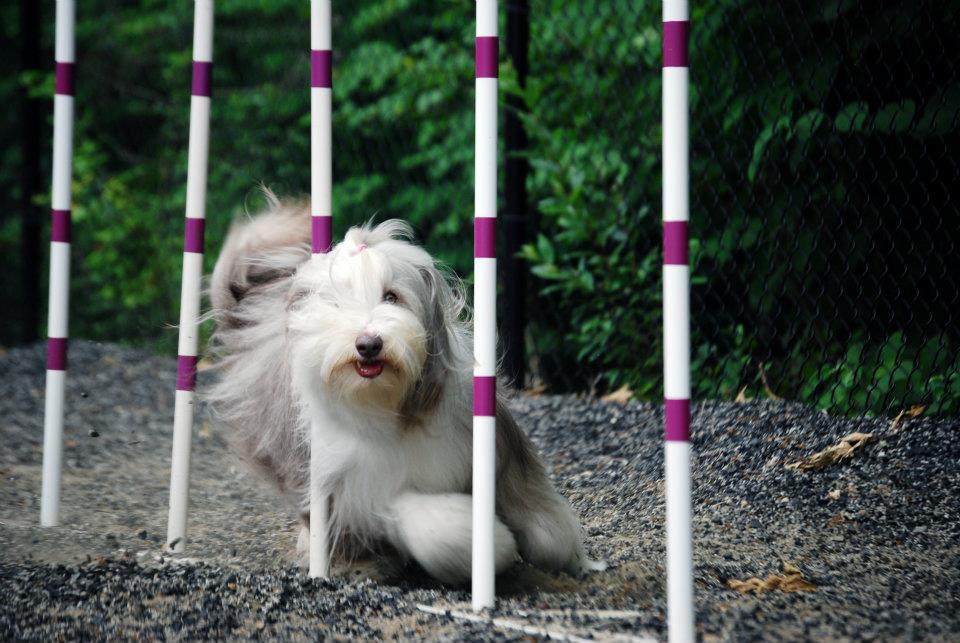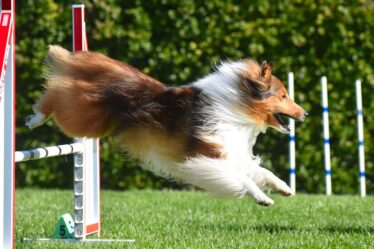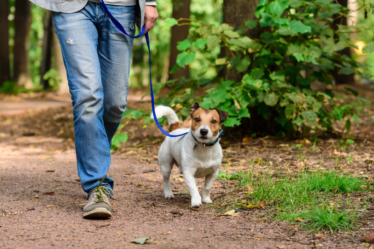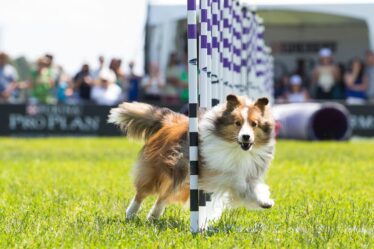
It’s heartbreaking to see your teammate stressed out, disconnected or shutdown mid-run. I’ve seen it happen with my own dogs and students’ dogs too. We want our dogs to love playing agility with us. This game is supposed to be fun for both of us. But, stress happens. Whether a team is training through chronic ring stress or a dog is suddenly insecure or unsure on course, there are many strategies we can use to support them. Being able to boost your dog’s confidence and help them cope with stress should be something every handler can do for their dog. So, here’s what I tell my students to do and how I set my own dogs up for success in even the most demanding trial environments.
Learn About Your Dog
Ask yourself when your dog loses confidence and struggles to focus on course. This is different for every dog, but there are a few common factors that contribute to ring stress. Possible factors range from your relationship with your teammate to the color of the judge’s mask. We’ll take a look at three common factors that are easy to recreate in training.
This starts off with the environment. The uncertainty of being in a new space around new dogs, smells and noises can create anxiety that shows up as our typical ring stress behaviors. My first suggestion for this is allowing time for your dog to sniff and explore the trial site. This is not an instantaneous fix. But, allowing your dog to become familiarized and comfortable in new environments can help them be more adaptable to new environments in the future. If your dog is fixated on the ring or nervous of certain areas move to a distance where they can focus on cues and physically relax. I recommend repeating this throughout the day to allow your dog multiple opportunities to understand their surroundings.
People are another factor I often see impacting a dog’s ability to stay connected on course. This can be people in or around the ring. The number of people and the proximity of a specific person, like ring crew, to your dog might impact their stress level and distractibility. If your dog always trains alone or with just one instructor in the practice field, stepping into a ring with half a dozen strangers might throw them off their game. A judge that follows your dog closely in the weaves or a crowd of people behind your dog on the start line can take up attention and energy that your dog needs to do agility . To help we can start including more people, new people and people in odd places when practicing. Our objective is not to overwhelm our dog, but to successfully complete a sequence or obstacle while a person is acting as a distraction. At first, a person standing on the other side of the room might be distracting enough. As your dog succeeds, you can begin adding multiple people and people in motion around the practice ring.
We often see ring stress occur before or during complicated obstacles, like weaves or the contacts, or during complex sequences. This is because these complex tasks require more concentration from the dog than they have to offer when over stressed. This type of issue is separate from obstacle specific issues; just because the stress appears before the weaves does not mean the weaves are the cause of the stress. For example, your dog pops the poles when the weaves are on the edge of the ring. The pop was due to a dog outside the ring walking by, but handlers will often focus their training solely on the obstacle. Believing their dog has poor weave poles, the handler never practices with moving spectators or distractor dogs. The popping issue persists. This is where failing to help our dogs appropriately cope with ring stress can intensify an obstacle specific issue. A dog that is continuously corrected for popping or continues to fail in the ring might develop stress specific to the weaves. Now, this is the exact spiral I want to prevent my students and all agility teams from experiencing. So, here’s what we do.
We keep training and reinforcing your dog’s agility skills beyond what you’ll need in a trial. An increase in ability and consistently rewarding criteria can increase your dog’s competence with a specific task and boost their confidence in the ring. This type of progress takes time, and we can support our dogs by keeping it simple and keeping them successful in the ring. Skip the challenges you know they can’t do, we don’t want to set our dogs up for failure. Don’t try to fix mistakes over and over, if your dog is distracted and stressed the best thing you can do is keep moving and find an obstacle they can complete successfully! If you are looking to train a certain issue, like avoiding an obstacle or start lines, in the ring you better be prepared to reward big. Choose your dog’s favorite toy and opt for FEO (For Exhibition Only) or NFC (Not For Competition) at your next trial. If your dog succeeds, party like 2020 is finally over. If your dog doesn’t succeed, find an obstacle or behavior that they can succeed at. Then, you guessed it, party.
Note: I don’t recommend parties for dogs with over arousal issues. Flash, a rehabilitated(ish) arousal junky, gets pets and quiet praise as a reward. Once she’s relaxed, we release her extra energy with tugging. Arousal issues in agility really are their own topic for another day.
If you can recreate these confidence issues easily in practice, you may want to discontinue trialing for a period of time to stay in a more controllable environment. We want to practice agility in environments where our dog can still be successful.
Sniff Worries Away
No more “No, sniff!”. Sniffing is one of the main ways our dog’s gain information about their environment. If your dog is stressed due to noise, people, other dogs or whatever else, correcting and preventing sniffing can further increase their anxiety. Nothing makes stress more stressful than adding uncertainty to the situation. Sniffing provides our dog’s with useful information and can make an environment feel more familiar. Our goal shouldn’t be to eliminate sniffing, rather give your dog adequate time for sniffing before you need them to focus on agility.
Take time to let your dog explore and sniff their way around the trial site. You can even encourage sniffing by putting it on a verbal cue, we say “Go Sniff, Sniff”, or doing a small treat scatter (far, far away from the ring). The scents around the ring are similar to what smells will be on the agility course too. This helps desensitize our dogs to smells in the environment that might be distracting upon first sniff, sniff.
Build a Connection Behavior
What will you do if everything goes wrong? Your dog yawns on the start line or starts sniffing at the weaves and you need a way to reconnect with them. Asking them to “Come” or calling their name doesn’t create enough motivation or instruction for your dog to re-engage with you. Typically, this is because verbal cues like “Come” and “Fido” lack specific criteria and the strong reward history we need. We might say our dog’s names three dozen times a day with no reward or purpose. When we get to the trial, our dogs simply don’t understand the behavior you expect when calling their name. Instead we need to choose and use cues that are specific, easy and always rewarded. These should be behaviors that are enjoyable for our dogs. Using a hand touch, spin, or asking for your dog’s favorite trick can give your dog an easy win and help them re-engage with the game of agility.
Here’s the deal – you need to practice using your connection cue. Whether you’re at agility class or at home, whenever your dog makes a mistake or disconnects use your connection cue and reward it. Jackpot it, have a party about it. Use the best cookies and their favorite toy. Work your tail off to make this connection behavior an utter joy for your dog to complete. This is the only way for a connection cue to make a meaningful difference in a trial environment. Quite simply, you gotta train it if you wanna use it!
Be a Proactive Handler
When you know you’re going to encounter a distraction, craft your handling plan to support your dog best throughout the run. This is different for every team – here are some examples of proactive handling might help you and your dog.
1) You may find staying closer to your dog boosts their confidence. You can choose to avoid long lead outs and distance on course. You can also use yourself as a buffer between your dog and a distraction. If the weaves are along the fence with teams waiting to run, pick a handling plan that puts you between the weaves and the fence. You’ll add support by being close to your dog and provide a visual barrier between your dog and the other teams watching.
2) Change how you use your voice on course. Mostly, this means managing your tone. High pitched or squeaky noises from you can trigger anxiety in your dog. Yes, they can hear the panic in your voice. To help, keep your voice deep and clear. You can also increase verbal support by using clear reward markers, like “Good” and “Yes”, throughout your run. However, we do want to avoid useless chatter, “Good dog, let’s go, hurry. Okay, Fido, here we go, tunnel.” Adding extra words without intention can distract your dog from information they actually need, like what obstacle to take next!
3) Plan to use your connect cue before your dog disconnects. If your dog consistently runs around the weaves on the first attempt, as you approach the weaves you should use your connection cue to keep them on task. While this might not guarantee a perfect set of poles, you’ll start to interrupt the run-by behavior. A connection cue with strong reward history (i.e. always rewarded) should help you alter your dog’s association with the weaves and give your dog the best chance at success in the ring.
To those of you on this training journey, it’s a process. It will take time. You will make a mistake, or two, or three. Please, be gracious with yourself and your dog. In the end you’ll be a better dog trainer and you’ll strengthen your relationship with your dog. We can teach them how to love this sport as much as we do.



